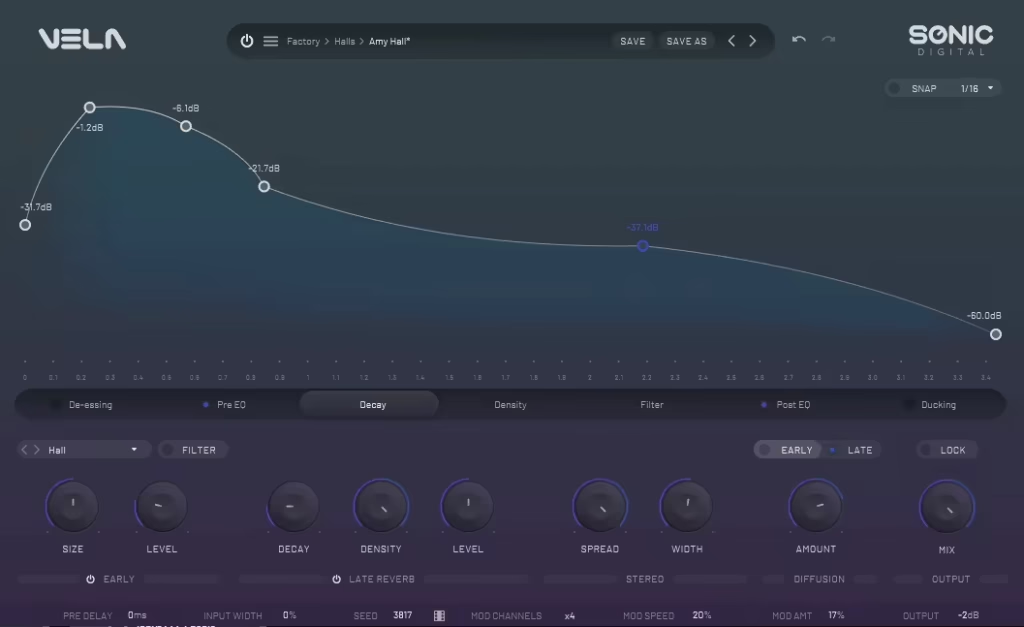This post is a deep dive into some of the most distinctive reverb plugins available today, comparing how each approaches space, depth, and realism in completely different ways.
It covers both algorithmic and plate-style reverbs, highlighting tools that range from the precision of FabFilter Pro-R 2 and iZotope Aurora to the experimental depth of Lese Hikari and Sonic Academy VELA.
What stands out is how the post balances technical insight with real mixing perspective – each section reads like a producer sharing hands-on impressions rather than a spec sheet. Together, these reviews form a comprehensive look at how today’s reverbs blend innovation, usability, and sonic personality across digital and analog-inspired designs.
1. Sonic Academy VELA
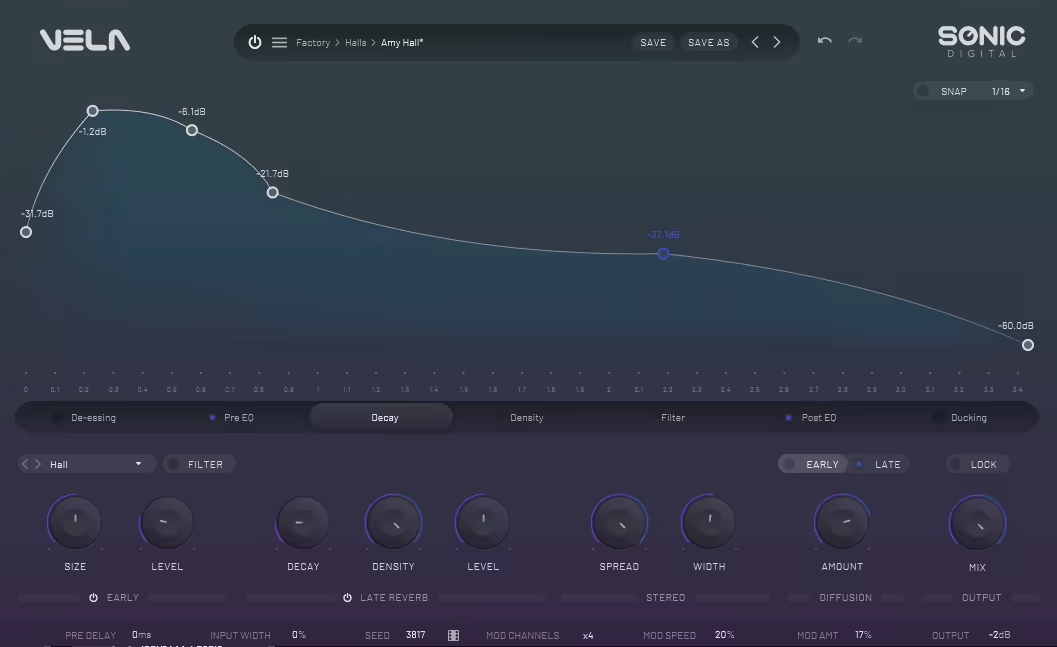
There have been a lot of reverbs that promise realism and depth, but VELA VST actually earns it. What makes it different is the way it treats reflections – you’re not just adjusting sliders, you’re shaping how sound blooms and fades using its node-based graph system. It’s like drawing your own acoustic fingerprint instead of loading another “Hall A” preset.
I’ve found it incredible for vocals, especially with the ducking and de-essing built in, keeping everything lush but never messy.
Once you dial it in, VELA feels less like an effect and more like part of the room your mix lives in.
- Node-based reflection engine – VELA gives you full control over how reflections behave with its node-based graph editor. You can sculpt decay, density, and damping over time, letting you design anything from natural room spaces to massive evolving textures that move and breathe with your mix.
- Customizable early reflections – The plugin’s early reflection system can be fully edited or built from scratch, helping shape the sense of space with incredible precision. You can feed them into the diffusion and filter stages for even more control over tone and stereo depth.
- Integrated ducking and de-essing – VELA’s built-in ducking keeps your reverb out of the way until it’s needed, especially useful for vocals or lead instruments. The de-esser smooths out harsh sibilance before it hits the reverb tail, resulting in cleaner, more polished ambience.
- Modulation and diffusion control – With adjustable modulation channels, speed, and amount, you can bring subtle movement or intense shimmer into your tails. The independent diffusion controls for both early and late reflections help blend or separate the space exactly how you want it.
2. iZotope Aurora
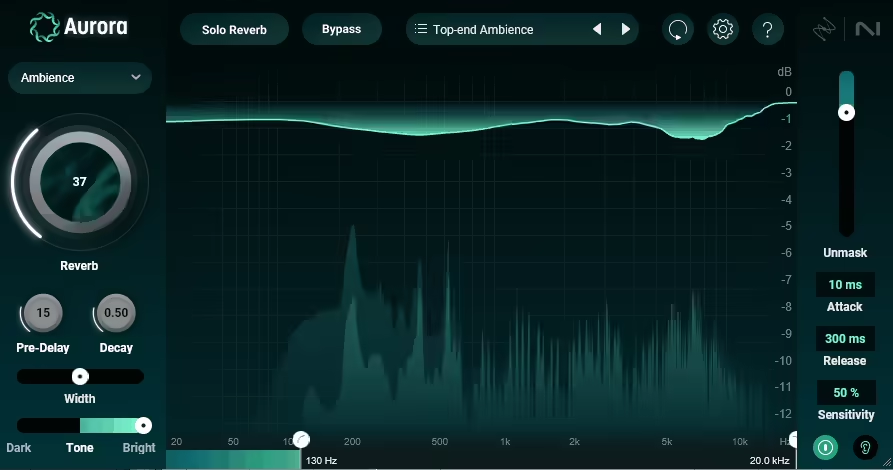
What caught my attention right away with iZotope Aurora is how it feels like the reverb is actually listening to your mix. Its adaptive unmasking is crazy effective at keeping vocals and instruments upfront while still surrounding them in a clean, airy space. I’ve been using it on drum busses and vocals, and it instantly tightens the mix without me having to EQ the reverb or stack plugins to control mud.
- Aurora stands out for its adaptive unmasking technology, which reacts in real time to your mix and clears up frequency clashes automatically. It keeps vocals, drums, and instruments clean and upfront without needing sidechain tricks or EQ workarounds.
- Built on Exponential Audio’s reverb engine, it offers the same rich, detailed sound you’d expect from top-tier reverbs while staying transparent and controlled. You can easily dial in anything from tight studio spaces to lush, atmospheric halls using six distinct reverb types.
- With over 60 professional presets, Aurora makes it easy to find a sound that fits your track instantly. From subtle vocal ambience to deep, cinematic tails, every preset feels polished and mix-ready.
- The intuitive interface keeps everything fast and fluid, letting you shape depth, width, and tone without breaking creative flow. It feels effortless to use, even in the middle of a busy session.
3. FabFilter Pro-R 2
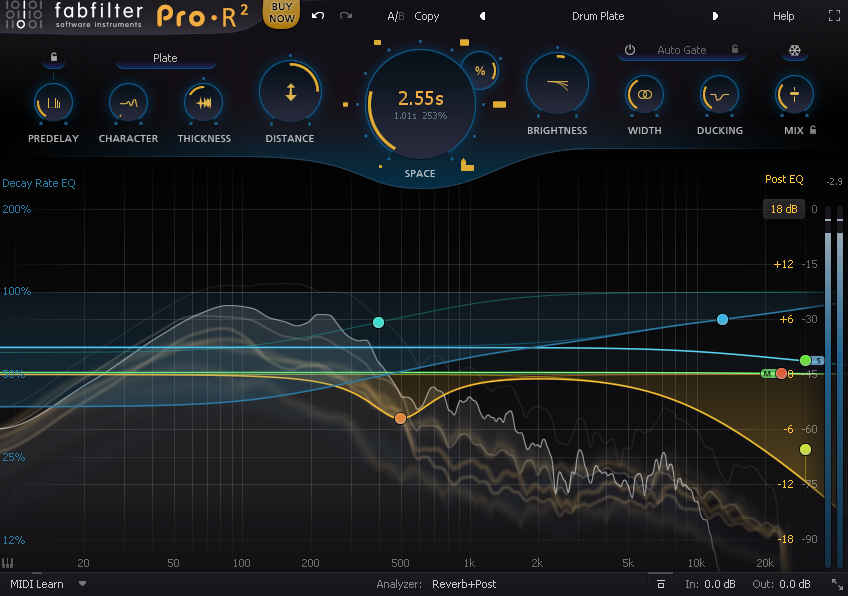
Few reverbs manage to balance control and simplicity without getting in the way of creativity. The interface feels natural, every tweak responds musically, and the sound always seems to sit right where it should in the mix. FabFilter Pro-R 2 nails that sweet spot between realism and character, giving me the space and texture I need without overcomplicating the process.
It’s clean, detailed, and honestly one of those plugins I reach for without thinking twice.
- One of the biggest highlights here is the decay rate EQ, which lets you control how different frequencies fade out over time. It’s a unique approach that helps shape reverb tails in a musical way, making it easy to design anything from tight rooms to long, evolving halls without frequency buildup.
- The space control is a smart, stepless parameter that moves between multiple room models while automatically matching decay time for a natural transition. It gives you instant access to a range of acoustic spaces that stay smooth and cohesive as you adjust.
- Another standout is the addition of vintage and plate algorithms, perfect for recreating classic 80s digital units or metallic plates with modern precision. Paired with the new thickness and ducking options, it’s easy to blend the reverb into a mix without overpowering the dry signal.
- Finally, the impulse response import feature analyzes IR files and converts them into editable settings inside Pro-R 2. That means you can capture the vibe of your favorite reverb hardware or space, but still tweak it freely inside the plugin.
4. Vallhala DSP VintageVerb
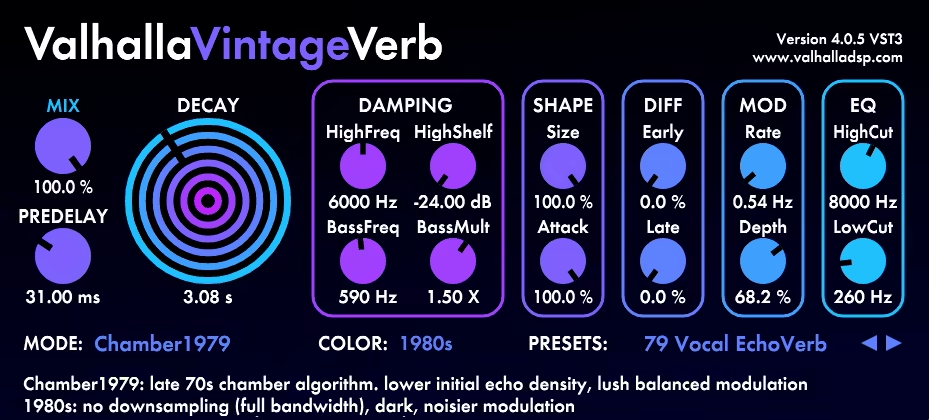
Sometimes I just want a reverb that instantly gives me character without endless tweaking, and that’s exactly where Valhalla VintageVerb shines. It’s packed with those 70s and 80s digital textures that sound huge, colorful, and unapologetically vintage in the best way.
The color modes are brilliant too, letting me switch between dark, noisy retro grit and clean, modern clarity with one knob. Whether I’m adding shimmer to synths or that classic gated snare vibe, this thing nails the sound every single time.
- With 22 unique reverb algorithms, Valhalla VintageVerb covers everything from classic concert halls and plates to chaotic, experimental spaces. Each mode has its own texture and modulation style, making it versatile enough for subtle ambience or massive atmospheric effects.
- The Color control lets you move between three eras of sound – 1970s, 1980s, and Now – each adding its own tone and character. It’s not just EQ shaping; it changes bandwidth, modulation noise, and overall color to capture the vibe of different decades.
- The plugin’s smooth, musical modulation adds depth without harsh artifacts, using random delay variation and chorusing that makes every decay feel alive. It’s especially noticeable on synths, guitars, and pads where the tails feel lush but never metallic.
- With modern updates like Hall1984 and Chamber1979 modes, Valhalla keeps evolving while staying true to its vintage roots. These new algorithms expand the palette even further, giving producers fresh yet authentically retro options for reverb design.
5. Softube Dimensions
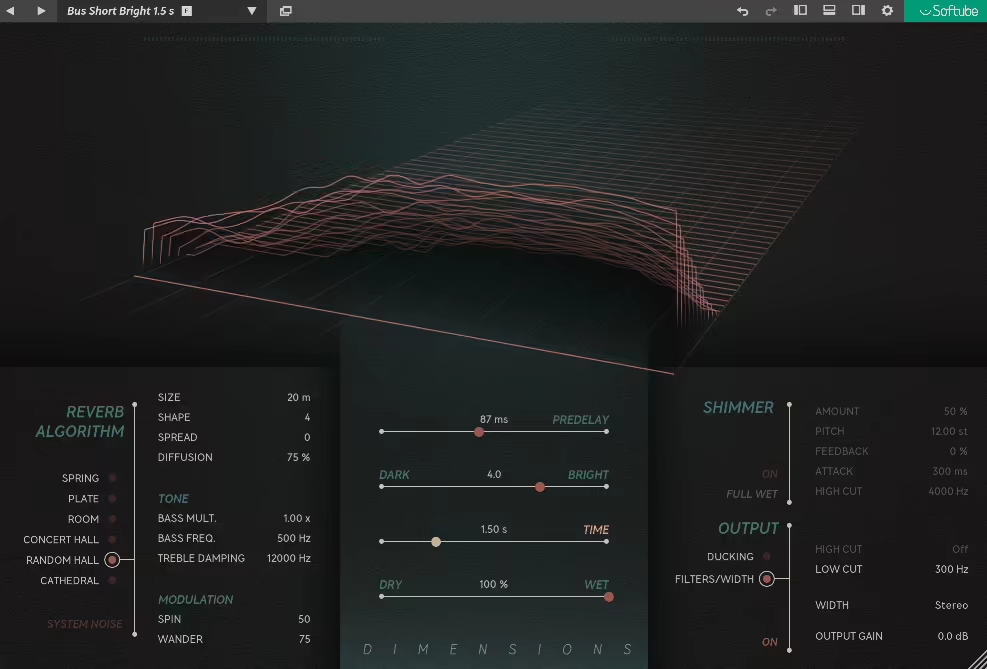
Some stereo effects try too hard and end up making a mix sound artificial. What I like here is how natural the movement feels, adding width and presence without losing focus in the center. Softube Dimensions really captures that classic chorus vibe that just melts into the sound rather than sitting on top of it. It’s the kind of tool that quietly makes everything feel bigger and more alive without calling attention to itself.
- Six reverb algorithms form the core of Softube Dimensions, giving you access to Spring, Plate, Concert Hall, Room, Random Hall, and Cathedral models. Each one captures a different sonic flavor, from tight studio ambiences to expansive, atmospheric spaces.
- The built-in shimmer effect transforms any reverb mode into a rich soundscape, adding a subtle pitch-shifted layer that’s perfect for ambient synths, pads, or cinematic textures. It’s a quick way to bring instant atmosphere without stacking extra plugins.
- An interactive reverb tail visualizer displays the shape and energy of your reverb decay in real time, helping you fine-tune reflections and tail length with visual feedback that actually feels musical.
- Over 100 presets are included, offering mix-ready reverbs for drums, vocals, guitars, and keys. Combined with easy controls for Time, Pre-delay, and Brightness, it’s quick to shape depth and space without overthinking it.
6. sonible smart:reverb 2
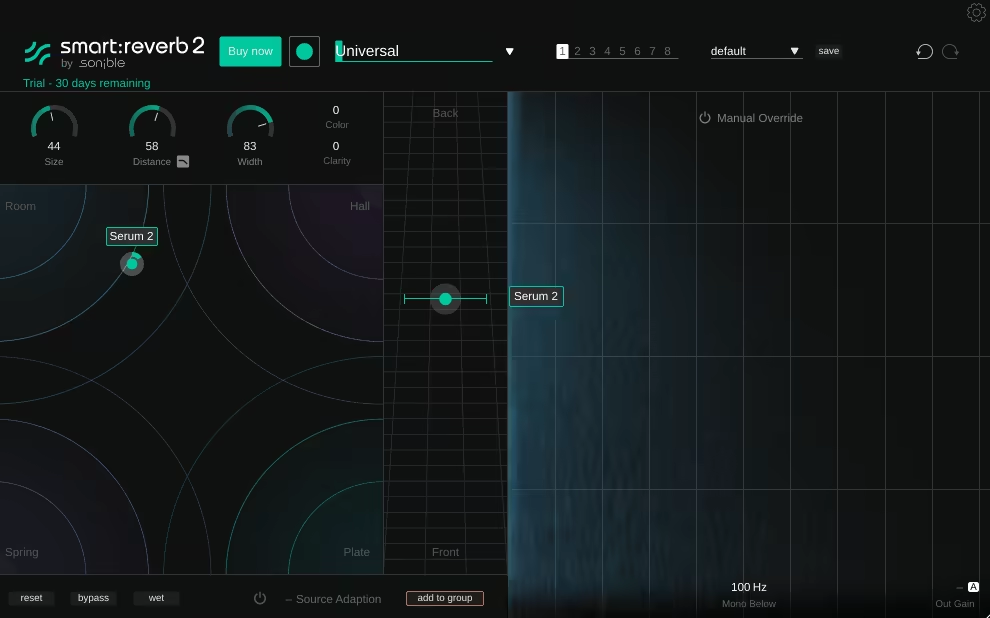
Most reverbs make you work to find a balance between space and clarity. What’s different about smart:reverb 2 is how it listens to your sound and builds a reverb that naturally fits around it. The AI actually adapts in real time, shaping tone and reflections so the space feels clean but still full of depth. I’ve been using it to place instruments in a mix more intuitively, and it genuinely makes depth staging feel effortless.
- The AI-driven processing in smart:reverb 2 analyzes your audio signal in real time and builds a custom reverb profile that matches the source’s tone and timing. This lets the reverb sit naturally in the mix without adding muddiness or masking other elements.
- A powerful distance control gives you precise control over spatial depth, allowing you to move instruments forward or backward in the mix intuitively. It automatically adjusts reflections and tail characteristics to maintain realistic depth and perspective.
- The group mode is a standout feature, letting multiple plugin instances communicate with each other to manage overlapping frequencies. This keeps the overall reverb field clean and coherent across the entire mix, even with multiple sources active.
- With its interactive Reverb Matrix, you can seamlessly blend between Room, Hall, Plate, and Spring styles while shaping Width and Color. It’s an easy and visual way to craft spaces that range from subtle realism to creative, atmospheric effects.
7. Lese Hikari
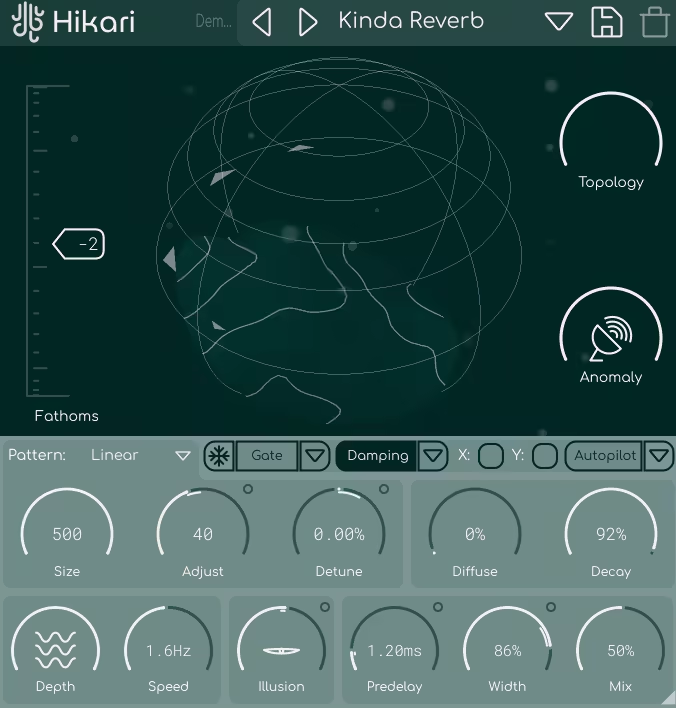
Some reverbs try to simulate real spaces, while others aim to create entirely new ones. This one falls deep into the second category, constantly shifting and reacting as you move through its environment. Hikari VST feels more like exploring an underwater world of reflections than using a standard reverb, and it’s incredible for crafting evolving, experimental atmospheres.
- The navigation system in Hikari gives you control over a two-dimensional space that directly influences the reverb’s tone and behavior. Each axis modulates multiple parameters in real time, creating hundreds of possible variations from a single movement, making it a powerful tool for evolving ambient design.
- The anomaly engine generates randomized trigger points that appear and disappear between plugin states. When you move close to one, the sound shifts unpredictably through unique reverb states and additional processing layers, meaning no two passes ever sound the same.
- The built-in Illusion processor uses granular reverse playback to create short, glitch-like echoes that feel detached yet musical. It reads from a small audio buffer (about a few hundred milliseconds), producing subtle rhythmic dislocations that blend beautifully with sustained material.
- The fathoms control lets you adjust perceived depth by applying multi-stage filtering and decorrelation across several frequency bands. It can range from a light shimmer at 1–2 fathoms to a deep, hazy space at 10+ fathoms, shaping how submerged or airy your reverb feels in the mix.
8. Ujam UFX REVERB Version 2
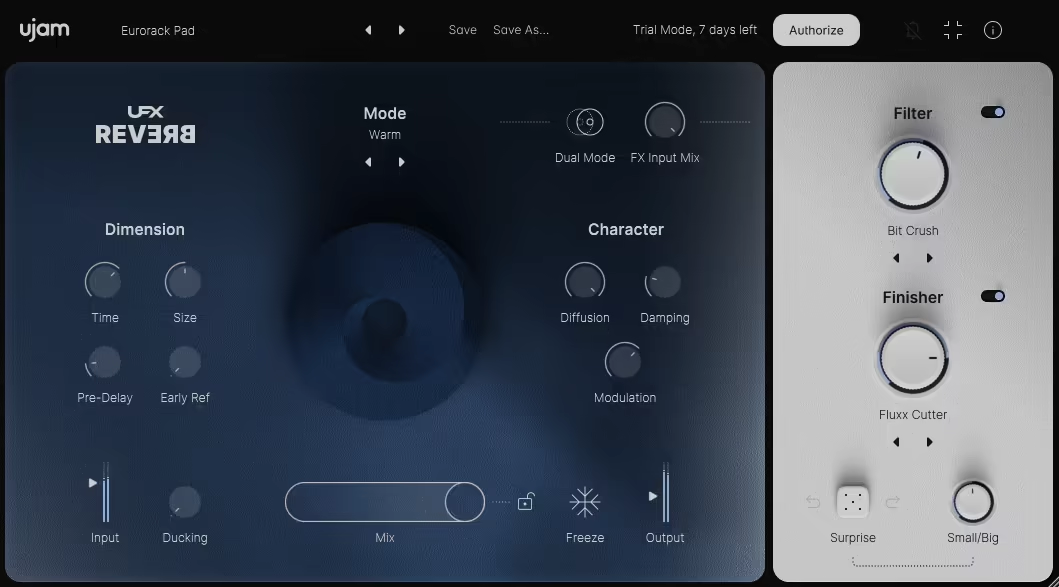
I’ve been testing out the new version, and it’s clear right away that this isn’t just a small update. UFX Reverb 2 feels much fuller and more flexible, especially with the new Dual Mode that instantly thickens and deepens the reverb field. The Early Reflections add a nice sense of space that helps vocals and drums sit more naturally in the mix.
What I really enjoy though is how the filter and finisher sections push it beyond a standard reverb, letting you sculpt wild, creative textures or keep things subtle and clean depending on what the track needs.
- Dual Mode instantly creates a fuller and denser reverb field by running two reverb engines at once. This gives even short spaces extra width and dimension, making instruments and vocals sound rich without stacking multiple plugins.
- Early reflections add improved spatial definition and realism, helping sounds sit naturally in the mix. They’re especially useful for drums and vocals, where small details in reflection timing make a huge difference in clarity.
- Twenty reverb models cover everything from classic rooms and plates to creative spaces like Gigathedral, Vocal Ice, and Fat Shimmer. Each model reacts musically to tweaks in size, modulation, and density, allowing for precise tone sculpting.
- Expanded Preset and Finisher Library introduces over 100 new presets, 15 filters, and 40 finishers that go far beyond standard reverb use. You can shape subtle studio ambience or dive into experimental, shimmering, and frozen textures for sound design.
9. Eventide Tverb
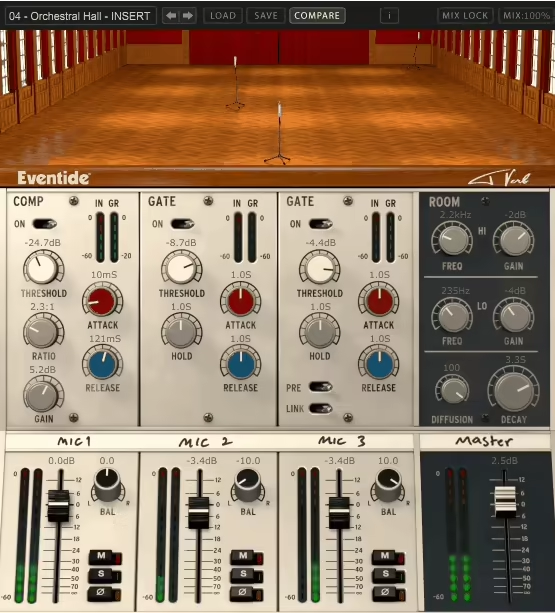
I didn’t expect to enjoy a reverb this much, but this one really stands out. Tverb plugin gives you a virtual version of the famous Hansa studio room, complete with three controllable microphones that you can move around to shape the sense of space in your mix. What makes it even more interesting is the built-in compression and gating, modeled after the setup Tony Visconti used on Bowie’s “Heroes.”
It’s a reverb that doesn’t just add space but actually feels like you’re performing inside a room with character and movement.
- Triple-Microphone System gives you one main mic and two fully moveable virtual microphones inside a modeled version of Berlin’s Meistersaal. You can adjust mic distance, placement, and angle to create natural depth, from close, intimate spaces to wide, immersive ambiences.
- Dynamic gating and compression replicate Tony Visconti’s legendary Bowie “Heroes” setup with analog-modeled compression on the main mic and two linkable post-reverb gates on the room channels. This setup brings dynamic movement and clarity to vocals, drums, and ambient sources.
- Advanced reverb engine uses Eventide’s algorithmic processing to provide full control over EQ, diffusion, and decay, while staying efficient on CPU. The built-in room mixer lets you fine-tune tone and space, shaping the reverb to sit naturally in the mix.
- Creative modulation and utility Tools allow real-time mic automation, phase inversion, and Mix Lock for fast preset switching. These features make Tverb not only authentic and musical but also a powerful creative tool for shaping evolving reverb spaces.
10. Soundtoys SuperPlate

There’s something about plate reverbs that just instantly adds class to a mix. I’ve been running vocals, snares, and synths through SuperPlate, and it nails that silky, metallic bloom that the old hardware units were famous for. What really sets it apart for me is how you can flip between five authentic plate models, then shape the tone with tube warmth, solid-state bite, or a totally clean path. The decay ducking and built-in EQ make it super easy to fit lush reverbs into a mix without things getting cloudy.
- Five classic Plate models give you the authentic sound of the EMT 140, EMT 240, Audicon, Stocktronics RX4000, and EcoPlate III, all carefully modeled for accuracy. Together, they cover over 60 years of plate reverb evolution, letting you move from warm vintage tones to modern, clean reflections.
- Three distinct preamp modes let you choose between Tube, Solid-State, or Clean operation. The Tube mode adds rich harmonic coloration modeled after the EMT V54, the Solid-State mode adds subtle compression inspired by the EMT 162, and the Clean mode delivers the pure, untouched sound of the plates.
- Auto-Decay feature intelligently adjusts decay time in real time based on the input signal. This keeps transient-heavy sounds like drums or vocals from getting lost in reverb tails, making it easier to maintain clarity and mix balance without manually automating levels.
- Built-In EQ and Filters provide detailed tone control with low-cut, high-cut, and two parametric bands. This setup allows you to sculpt reverb tails precisely, removing low-end buildup or enhancing high-end shimmer for perfect integration into any mix.
11. Arturia Rev PLATE-140
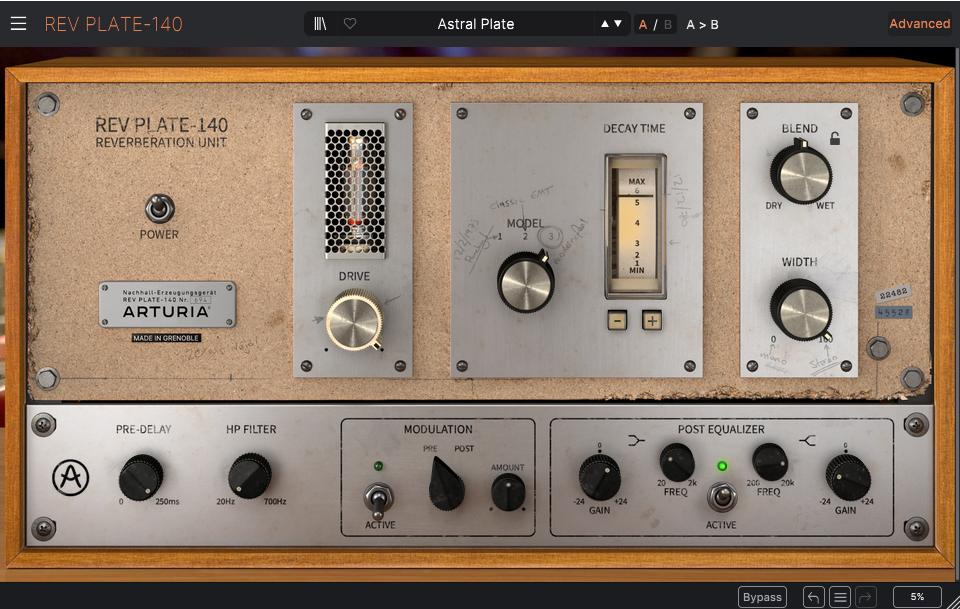
I’ve always loved the sound of vintage plate reverbs, and this plugin nails that classic tone. Rev PLATE-140 gives you the lush, smooth character of the original EMT 140 without the weight or maintenance of real hardware.
The built-in tube preamp adds warmth and grit when you want it, while the pre-filter, EQ, and modulation let you shape the sound to fit perfectly in your mix. It’s the kind of reverb that instantly gives vocals and drums that rich, professional sheen every bedroom producer wants.
- Three authentic plate models faithfully capture the tonal nuances of the legendary EMT 140, giving you options that range from tight and controlled to lush and open. Each model recreates the mechanical behavior and harmonic response of real plates, providing a realistic sense of depth and presence that instantly elevates vocals and instruments.
- Integrated tube preamp adds harmonic richness and analog-style warmth by modeling the original vacuum tube circuitry. You can drive it subtly for color or push it harder to introduce vintage-style saturation that helps your reverb sit perfectly in the mix.
- Built-in modulation and tonal shaping tools include a chorus-style modulation effect, pre-reverb high-pass filtering, and a post-reverb 3-band EQ. These controls let you add movement, remove muddiness, and fine-tune the tone of the decay without reaching for extra plugins.
- True analog emulation and physical modeling technologies combine precise circuit modeling with detailed acoustic simulation. This ensures that every reflection, resonance, and harmonic interaction behaves just like the original 600-pound hardware plate from the 1960s.
12. iZotope Neoverb
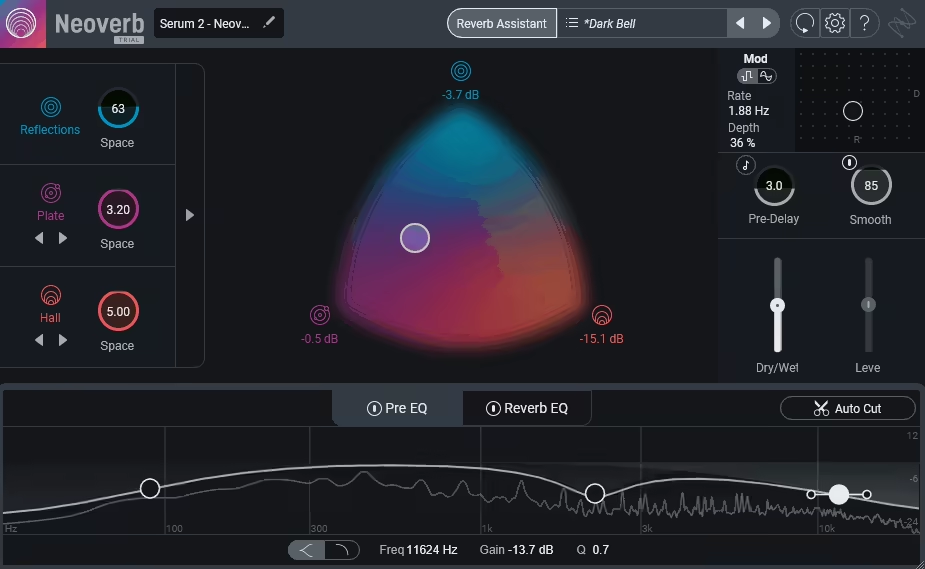
Getting reverb right can make or break a mix, especially when you’re working in a small studio or untreated room. I like how Neoverb VST plugin makes that process effortless by analyzing your track and building a reverb that fits naturally into the mix. The Blend Pad lets me combine different reverb types into one smooth, balanced sound without spending ages tweaking. Its smart EQ also keeps the low end clean and the highs clear, so the reverb adds depth instead of mud.
- AI-Powered Reverb Assistant intelligently analyzes your audio in real time to build the ideal reverb for your mix. It listens to your track, avoids masking, and automatically adjusts settings so you can create a balanced and natural sound faster than ever.
- Three-Reverb Blend Pad lets you mix up to three distinct reverb types, including Room, Plate, and Hall. You can freely move between them using an interactive visual pad or automate the movement in your DAW to add depth and motion to your mix.
- Smart EQ and Unmasking Technology clean up muddiness by reducing conflicting frequencies between dry and wet signals. This ensures your reverb adds space and clarity without clouding vocals or instruments.
- Powered by Exponential Audio Algorithms, Neoverb captures the lush realism of high-end hardware reverbs while staying lightweight on CPU. The result is an incredibly smooth and flexible reverb that works beautifully across any genre.
Bonus: Transatlantic Plate Reverb
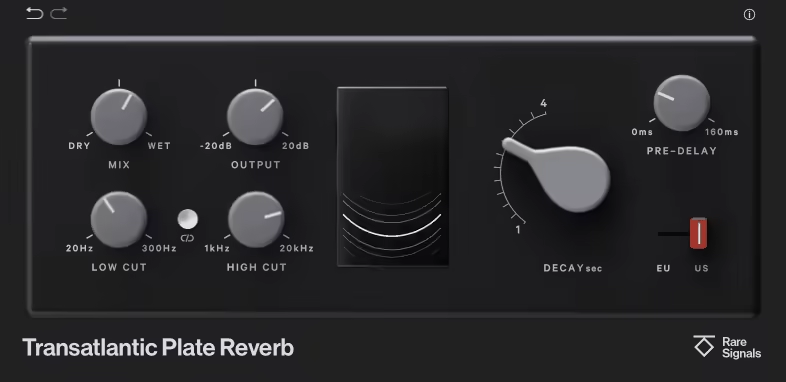
Getting a plate reverb to sound right can be tricky, especially if you want that authentic, rich character from the classic hardware units. What I love about the Transatlantic Plate Reverb is how faithfully it captures the tone and depth of those legendary European and American plates from the 60s and 70s.
- Authentic Dual-Plate modeling accurately recreates two of the most iconic analog plates ever made, one from Europe and one from the United States. Each plate was fully restored and tuned, delivering genuine hardware tone and depth straight from the golden era of recording.
- Unaltered reverb tails preserve the true, organic decay of real plates without any artificial processing. With 24 unique decay settings, the plugin maintains the natural sustain and stereo spread that make analog plates sound so musical and alive.
- Extended decay performance goes beyond the original hardware by achieving up to 6 seconds of real decay time on the European plate, one full second longer than the vintage specification, offering deeper and more immersive reverb spaces.
- Simple, streamlined operation keeps the workflow intuitive and musical. You can start shaping your sound instantly, while still having access to advanced settings for automation, decay modes, and CPU optimization when needed.
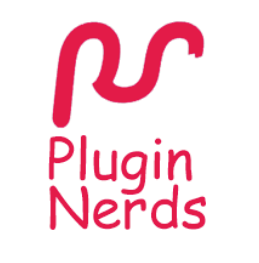
We are plugin nerds (just like you!). We made this website to keep you updated on the latest trends, news and everything plugin related.

